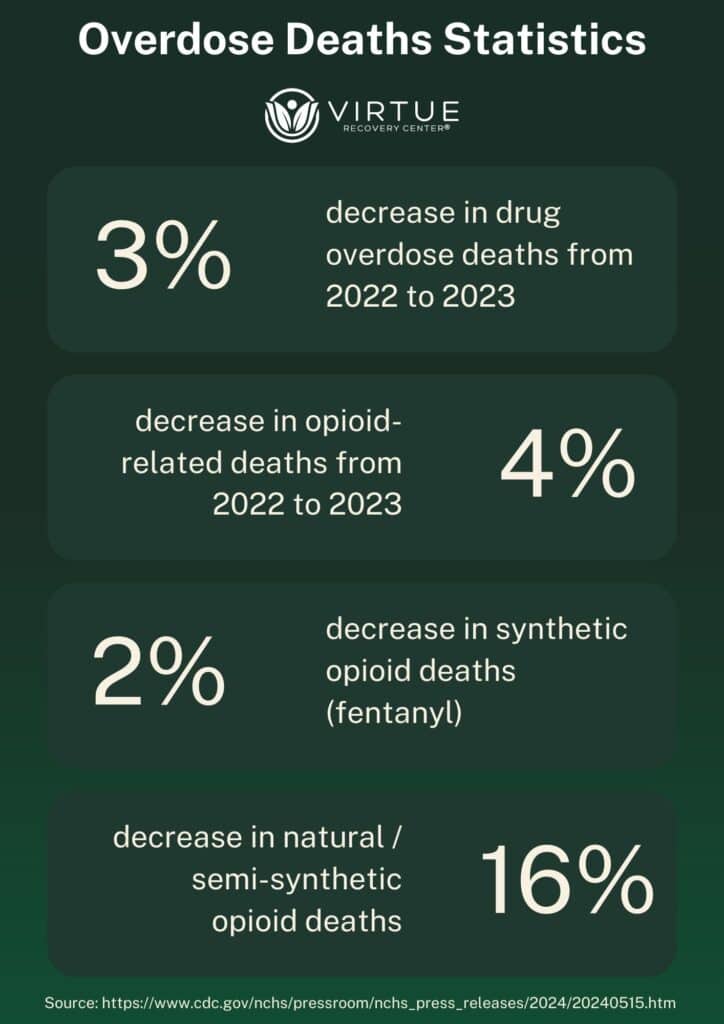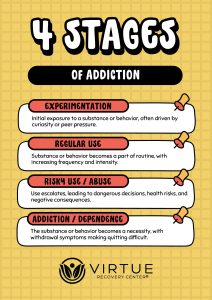Key Takeaways
- Drug overdose deaths in the U.S. decreased by 3% in 2023, marking the first decline since 2018.
- Opioid-related fatalities, including synthetic opioids like fentanyl, have seen modest declines.
- Some states experienced significant decreases in deaths, while others saw increases, highlighting regional disparities.
Introduction to Decline in Drug Overdose Deaths in 2023 & 2024
Drug overdoses have been a significant public health crisis in the United States for years, with deaths steadily rising year after year. However, 2023 brought an encouraging shift. For the first time since 2018, overdose deaths decreased, providing a glimmer of hope amid the ongoing crisis.
New data shows a 3% drop in overdose deaths, signaling the potential impact of expanded harm reduction strategies and public health interventions. While challenges remain, these statistics remind us that progress is possible with continued efforts.
Overview of Drug Overdose Trends in The U.S.
The United States has faced a relentless overdose crisis, particularly since synthetic opioids like fentanyl became prevalent. Between 2018 and 2022, overdose deaths rose consistently, peaking at 111,029 fatalities in 2022.
In 2023, the trend shifted, with overdose deaths decreasing to 107,543—a modest yet significant 3% decline. This drop marks a turning point, showing that public health measures can save lives and reduce harm when implemented effectively.
Key Statistics: Changes in Drug Overdose Deaths
A deeper look at the data reveals critical trends shaping the overdose crisis:
- Total Overdose Deaths: Decreased from 111,029 in 2022 to 107,543 in 2023.
- Opioid-Related Deaths: Declined from 84,181 in 2022 to 81,083 in 2023.
- Synthetic Opioids (Fentanyl): Fatalities fell slightly, from 76,226 in 2022 to 74,702 in 2023.
- Psychostimulants (Methamphetamine): Deaths increased from 35,550 to 36,251 in 2023.
- Cocaine-Related Deaths: Rose from 28,441 to 29,918 in 2023.
- Natural/Semi-Synthetic Opioids (Prescription Painkillers): Decreased from 12,135 to 10,171 in 2023.
Regional data highlights significant variations. States like Nebraska, Kansas, Indiana, and Maine experienced declines exceeding 15%, while Alaska, Washington, and Oregon reported increases of 27% or more.
Factors Behind the Drop in Overdose Deaths
Several factors contributed to the first annual decrease in overdose deaths since 2018:
- Harm Reduction Programs: Efforts to distribute naloxone (Narcan) widely have empowered communities to prevent fatal overdoses.
- Expanded Access to Treatment: Increased availability of addiction treatment programs, including Medication-Assisted Treatment (MAT), has played a role.
- Public Awareness Campaigns: Educational initiatives about the dangers of fentanyl and other drugs have raised awareness.
- Policy Changes: Many states have implemented overdose prevention strategies, such as Good Samaritan laws and syringe exchange programs.
Despite these improvements, challenges remain. Psychostimulants like methamphetamine and cocaine continue to claim more lives, highlighting the need for tailored interventions.
Provisional Data for 2024: Emerging Trends
Preliminary data for 2024 suggests a continuation of positive trends in some areas. For instance:
- Vermont: A 22% decrease in drug overdose deaths.
- King County, Washington: Fatal overdoses linked to all drugs fell by 15%, with fentanyl-related deaths dropping by 20%.
These declines demonstrate the potential impact of sustained public health efforts. However, the variability across states underscores the need for localized strategies to address each region’s unique challenges.
The Role of Harm Reduction and Public Health Interventions
Harm reduction measures have been pivotal in reducing overdose deaths:
- Naloxone Distribution: The widespread availability of this life-saving medication has saved countless lives.
- Syringe Exchange Programs: These initiatives reduce the risk of infections and provide an entry point for treatment.
- Education Campaigns: Raising awareness about the potency of synthetic opioids and overdose prevention is crucial.
Public health agencies and community organizations continue collaborating on innovative approaches to combat the crisis. However, these efforts must be sustained and expanded to address emerging challenges effectively.
Looking Ahead: Sustaining Progress
While the decrease in overdose deaths is encouraging, maintaining and building on this progress requires ongoing effort:
- Expand Treatment Access: Ensure more individuals have access to MAT and counseling.
- Address Psychostimulant Overdoses: Develop targeted interventions for methamphetamine and cocaine-related deaths.
- Invest in Research: Support studies to identify effective prevention and treatment strategies.
- Promote Community Engagement: Empower local communities to implement harm reduction programs tailored to their needs.
Long-term solutions require a holistic approach, combining prevention, treatment, and support for those affected by addiction.
Conclusion
The decrease in drug overdose deaths in 2023 represents a milestone in the fight against the overdose crisis. While challenges remain, progress underscores the importance of harm reduction, public health initiatives, and community collaboration.
If you or a loved one is struggling with addiction, help is available. Call Virtue Recovery Las Vegas at 866-520-2861 to start your journey toward recovery and a brighter future.

FAQs About Overdose Statistics in 2023 & 2024
What Does the Decrease in Overdose Deaths Mean for Public Health?
The decrease signals progress in addressing the overdose crisis and highlights the effectiveness of harm reduction and treatment programs.
Why Did Overdose Deaths Decrease in 2023?
The decline is attributed to harm reduction measures, expanded access to treatment, and increased public awareness about the dangers of synthetic opioids.
What Drugs Are Still Causing Overdose Deaths?
Synthetic opioids like fentanyl remain a leading cause of fatalities, but psychostimulants and cocaine are contributing to a growing share of deaths.
How Can Communities Prevent Overdose Deaths?
Communities can prevent overdoses by distributing naloxone, promoting education campaigns, and supporting harm reduction initiatives like syringe exchange programs.
What Should I Do if Someone I Know Is Struggling With Addiction?
Seek professional help immediately. Contact a treatment center to explore detox and recovery options tailored to their needs.
What Additional Things Could Be Done to Drop The Deaths Involving Any Opioid Overdoses in The Future?
Expanding access to naloxone (Narcan) and overdose prevention programs can save lives. Increasing funding for addiction treatment centers, harm reduction services, and education about opioid risks are essential. Stricter regulation of synthetic opioids like fentanyl and better prescription practices for pain management can also play a significant role.
What Are The Different Drug Categories?
Drugs are typically categorized into depressants (e.g., alcohol, benzodiazepines), stimulants (e.g., cocaine, methamphetamine), opioids (e.g., fentanyl, heroin), hallucinogens (e.g., LSD, psilocybin), and cannabinoids (e.g., marijuana, synthetic cannabinoids). Each category affects the body and mind differently and carries unique risks. Misuse of substances across these categories often leads to health complications and addiction.
What Are Contributing Factors to The Overdose Crisis?
The overdose crisis is fueled by the widespread availability of synthetic opioids like fentanyl, which are potent and often mixed with other drugs unknowingly. Other contributing factors include inadequate access to addiction treatment, mental health challenges, and social determinants like poverty and unemployment. A lack of education and awareness about drug potency and risks further exacerbates the problem.
Resources
https://www.dea.gov/resources/facts-about-fentanyl
https://www.npr.org/2024/09/18/nx-s1-5107417/overdose-fatal-fentanyl-death-opioid
https://www.nytimes.com/2024/09/21/us/politics/drug-overdose-deaths-decrease.html













